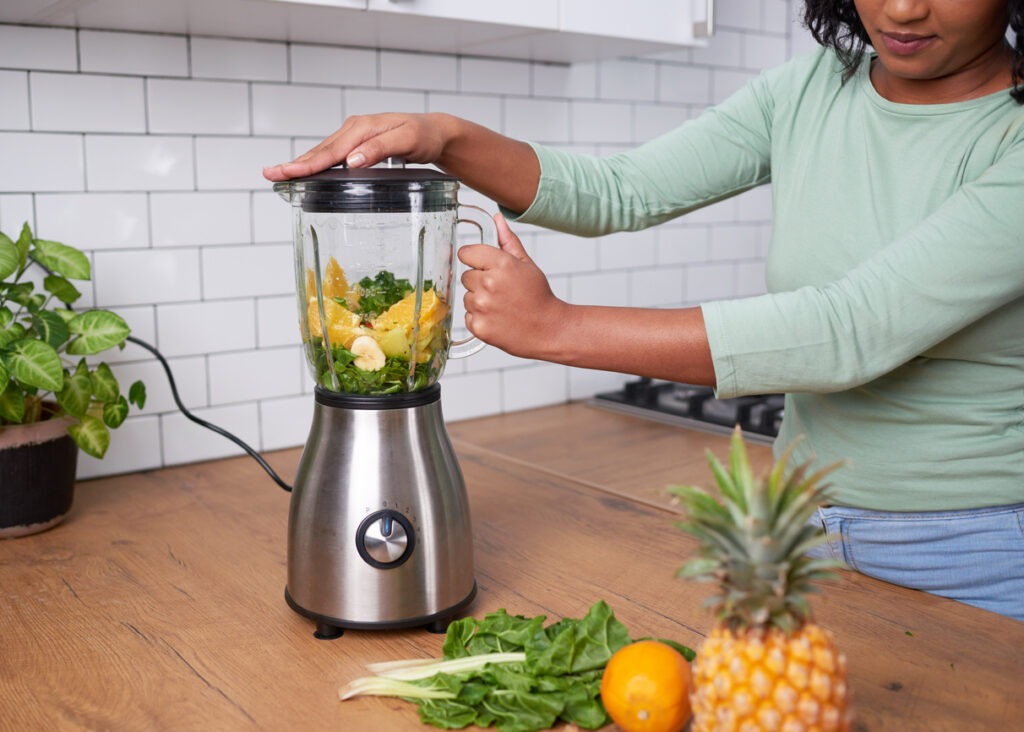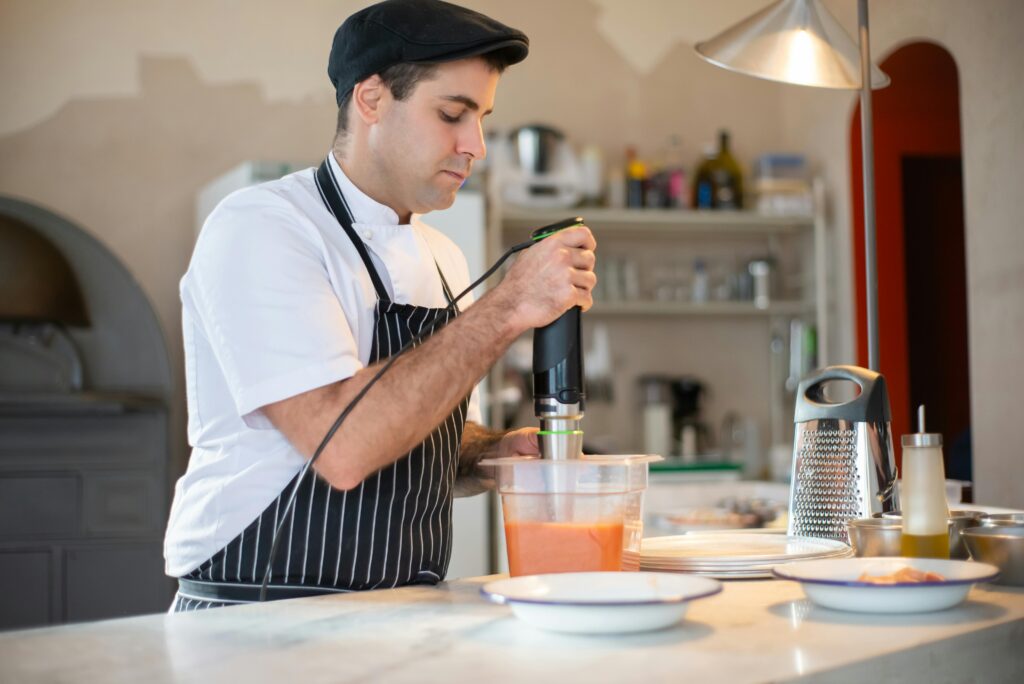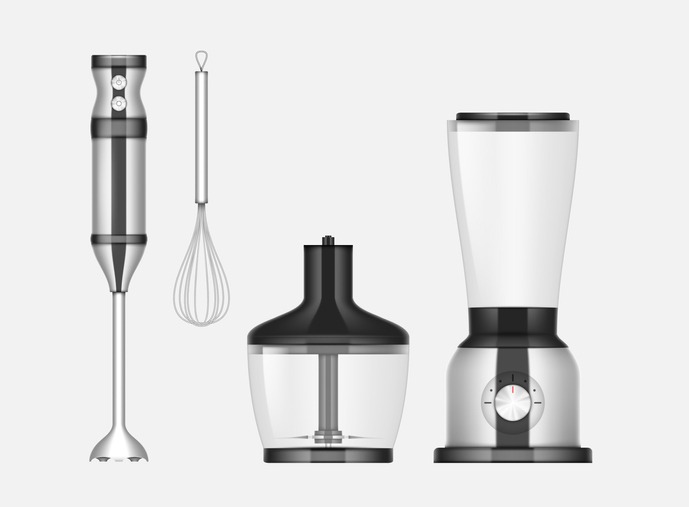While you might think the electric blender is just another kitchen gadget, its invention in 1922 by Stephen J. Poplawski was nothing short of revolutionary, paving the way for a new era in food preparation.
This device transformed kitchens around the globe, offering an unprecedented level of convenience for blending fruits, vegetables, and other ingredients. The introduction of Fred Waring’s Miracle Mixer in 1937 further cemented the blender’s place in culinary history.
Yet, the journey from Poplawski’s initial patent to the blender’s role in modern kitchens is filled with intriguing developments and innovations. Exploring this path reveals how a simple concept forever altered the culinary landscape, hinting at a rich tapestry of history that extends far beyond mere appliance evolution.
The Dawn of Blending
The dawn of blending began in 1922 when Stephen J. Poplawski invented the electric blender, revolutionizing how we mix fruits and vegetables. This pivotal moment marked a significant leap in kitchen appliance innovation, transforming the way you prepare your meals and beverages. Poplawski’s creation, the precursor to modern blenders, laid the groundwork for blending as an essential kitchen process.
By focusing on the design and functionality of his electric appliance, Poplawski ensured his blender wasn’t just a fleeting novelty but a durable, essential tool for culinary tasks. His initial model, though basic by today’s standards, introduced the concept of an electric motor powering a spinning blade at the bottom of a container—a design principle that remains at the heart of blender technology.
The introduction of the Miracle Mixer, which later became known as the Waring Blendor, in 1937, further cemented the electric blender’s place in homes and commercial settings. This model, boasting materials like chromium-plated metal, Pyrex glass, and rubber, showcased a commitment to durability and efficiency. It was a testament to the evolving design and capabilities of blending appliances, ensuring that the art of blending would continue to be an integral part of food preparation.
Patented Perfection in 1922
Building on the groundbreaking work in blending, Stephen J. Poplawski secured a patent for his electric blender in 1922, a move that solidified blending’s role in food preparation. His patented invention was designed specifically to reduce fruits and vegetables to a liquid form, making it a game-changer. Before this innovation, the idea of turning solid foods into smooth, drinkable concoctions was not a common practice in kitchens. Poplawski’s electric blender revolutionized how people approached food preparation by introducing an efficient, effective way to blend.
| Year | Milestone |
|---|---|
| 1922 | Stephen J. Poplawski patents the electric blender |
| 1932 | The electric blender receives further patents, underscoring its success |
| 1937 | Paves the way for the Miracle Mixer/Waring Blendor |
This table highlights the critical points in the journey of the electric blender from its inception to becoming a staple in food preparation. Poplawski’s invention not only introduced blending as a culinary technique but also set the stage for future innovations in kitchen appliances. The electric blender’s ability to transform fruits and vegetables into a liquid form quickly became indispensable, marking a significant leap in the evolution of food preparation.
The Rise of the Waring Blender
You’ve seen how the electric blender started, but the Waring Blender’s journey takes it a step further. With its introduction in 1937, Fred Waring’s marketing genius not only brought it into homes but also into hospitals and labs, revolutionizing how we mix and blend.
Now, let’s explore how this blender made its mark, from its market debut to the technological innovations that set it apart.
Waring’s Market Debut
In 1937, Fred Osius introduced the market to the Miracle Mixer, which, with Fred Waring’s financial and marketing support, soon became known as the Waring Blender. This partnership not only led to the blender’s successful debut but also marked its entry into various sectors.
The Waring Blender was showcased at the National Restaurant Show in Chicago, signaling its entrance into the commercial market. Its blending capabilities gained popularity in hospitals and scientific research, broadening its appeal beyond the kitchen. The collaboration between Fred Osius and Fred Waring was instrumental in the widespread adoption of the Waring Blender.
Their combined efforts transcended initial expectations, placing the Waring Blender at the forefront of innovation and utility in both domestic and professional settings.
Technological Innovations Unveiled
Often, technological advancements catapult products to fame, and the Waring Blender’s rise was no exception, propelled by significant innovations that reshaped its industry. Fred Osius invented the mixer, initially named the Miracle Mixer, before Fred Waring’s marketing genius led to its rebranding. Its technical construction allowed for versatility, making it a hit in both the home and scientific research, notably in Dr. Jonas Salk’s polio vaccine development. This blender’s journey from a kitchen appliance to a scientific tool underscores its innovation in the appliance industry.
| Year | Milestone | Impact |
|---|---|---|
| 1933 | Invention by Fred Osius | Birth of the blender |
| 1937 | Rebranding by Fred Waring | Enhanced marketing and popularity |
| 1954 | Millionth unit sold | Symbol of widespread adoption and popularity |
| – | Used in Polio Vaccine Dev. | Significance in scientific research |
Blender Evolution: Types and Uses
As you explore the journey from early blender models to their modern applications, it’s fascinating to see how they’ve evolved. You’ll find that countertop and immersion blenders now serve not just in making smoothies, but in a wide array of tasks across different industries. From grinding ingredients in commercial kitchens to aiding in scientific research, the versatility of blenders has significantly expanded.
Early Blender Models
Delving into the history of early blender models, you’ll discover a fascinating evolution in both design and functionality.
- Stephen Poplawski, often credited with Poplawski’s invention, was the first to patent a blender in 1922, laying the groundwork for future innovation.
- Fred Osius improved on this design, leading to the creation of the Waring Blender by 1937, with the financial backing of Fred Waring. Meanwhile, Chester Beach and Fred Osius developed durable models under the Hamilton Beach and Arnold Electric brands.
- Traugott Oertli’s contribution led to the development of the Vitamix blender, revolutionizing kitchen tasks. Additionally, immersion blenders emerged as versatile tools for homogenizing food directly in the pot.
These early models set the stage for the diverse applications blenders are known for today.
Modern Applications
Blenders have evolved significantly, now offering a wide range of types and uses that cater to both home cooks and professional chefs alike. Countertop blenders, with their 1-2 liter blending containers made of glass, plastic, or stainless steel, are perfect for mixing, puréeing, and chopping food.
Immersion blenders, handheld devices with rotating blades, excel in homogenizing large volumes, playing a critical role in commercial blending and specific tasks in various culinary settings. With speed settings ranging from 2 to 16, these modern applications of the electric blender meet diverse needs.
From grinding ingredients, making milkshakes, crushing ice for cocktails, to blending smoothies, their versatile functionality extends even to microbiology and food science, showcasing the profound impact of electric blenders in today’s culinary and scientific landscapes.
Global Spread and Adaptation
The Waring Blender’s international debut spurred a wave of innovation, leading to the creation of unique blending appliances across the globe. This global spread of blender technology was marked by significant milestones, showcasing the evolution of blending appliances.
- The Turmix Standmixer emerged in Switzerland in 1943, kickstarting a series of international innovations.
- Brazil witnessed the introduction of the Walita Neutron blender in 1944, soon to be joined by the Liquidificador Arno blender in 1947, each drawing inspiration from different aspects of blender design.
- Royal Philips acquired Walita in 1971, further solidifying the role of blending appliances on the international stage.
These pivotal moments highlight the dynamic evolution of blender technology, driven by the Waring Blender’s pioneering influence. Each innovation, from the Turmix Standmixer to the Walita Neutron and Liquidificador Arno blenders, not only contributed to the global spread of blending appliances but also reflected a deep appreciation for the original Waring Blender’s design and functionality.
Royal Philips’s acquisition of Walita represents a significant chapter in this ongoing narrative, underscoring the importance of blending appliances in kitchens around the world.
Impact on Culinary Culture
With the advent of the electric blender, you’ve witnessed a culinary revolution, seamlessly integrating a vast array of blended foods and drinks into daily life. Fred Waring’s promotion of the Miracle Mixer, later known as the Waring Blendor, was pivotal in this transformation. This device didn’t just change the way you mix ingredients; it reshaped culinary culture itself.
The electric blender made food preparation a breeze, popularizing the household adoption of this appliance. Its convenience and affordability at $29.75 meant that more people could enjoy the culinary possibilities it offered. Suddenly, blended beverages like smoothies, milkshakes, and frozen daiquiris weren’t just café treats but everyday pleasures you could whip up at home.
| Era | Innovation | Impact |
|---|---|---|
| 1930s | Miracle Mixer | Birth of home blending |
| Today | Waring Blendor | Culinary staple in kitchens |
| Future | ??? | Endless possibilities |
The historical impact of the electric blender on culinary culture is monumental. It diversified what could be easily prepared at home, turning the kitchen into a place of endless creativity and convenience. The legacy of Fred Waring and his blender continues to enrich your culinary experiences, proving that innovation in the kitchen is always just around the corner.
Conclusion
You’ve seen how the electric blender transformed kitchens worldwide. From Poplawski’s patented perfection in 1922 to the Waring Blender’s rise, this appliance has evolved into an indispensable tool. It’s reshaped culinary culture, making food preparation easier and more creative. Blenders have adapted globally, proving their worth across various cuisines. Your kitchen likely houses this innovative device, a testament to its enduring impact.
Truly, the blender’s journey from a novel invention to a culinary staple is a remarkable blend of history and innovation.






